CADILLAC CATERA 1998 1.G Owners Manual
Manufacturer: CADILLAC, Model Year: 1998, Model line: CATERA, Model: CADILLAC CATERA 1998 1.GPages: 346, PDF Size: 19.13 MB
Page 91 of 346
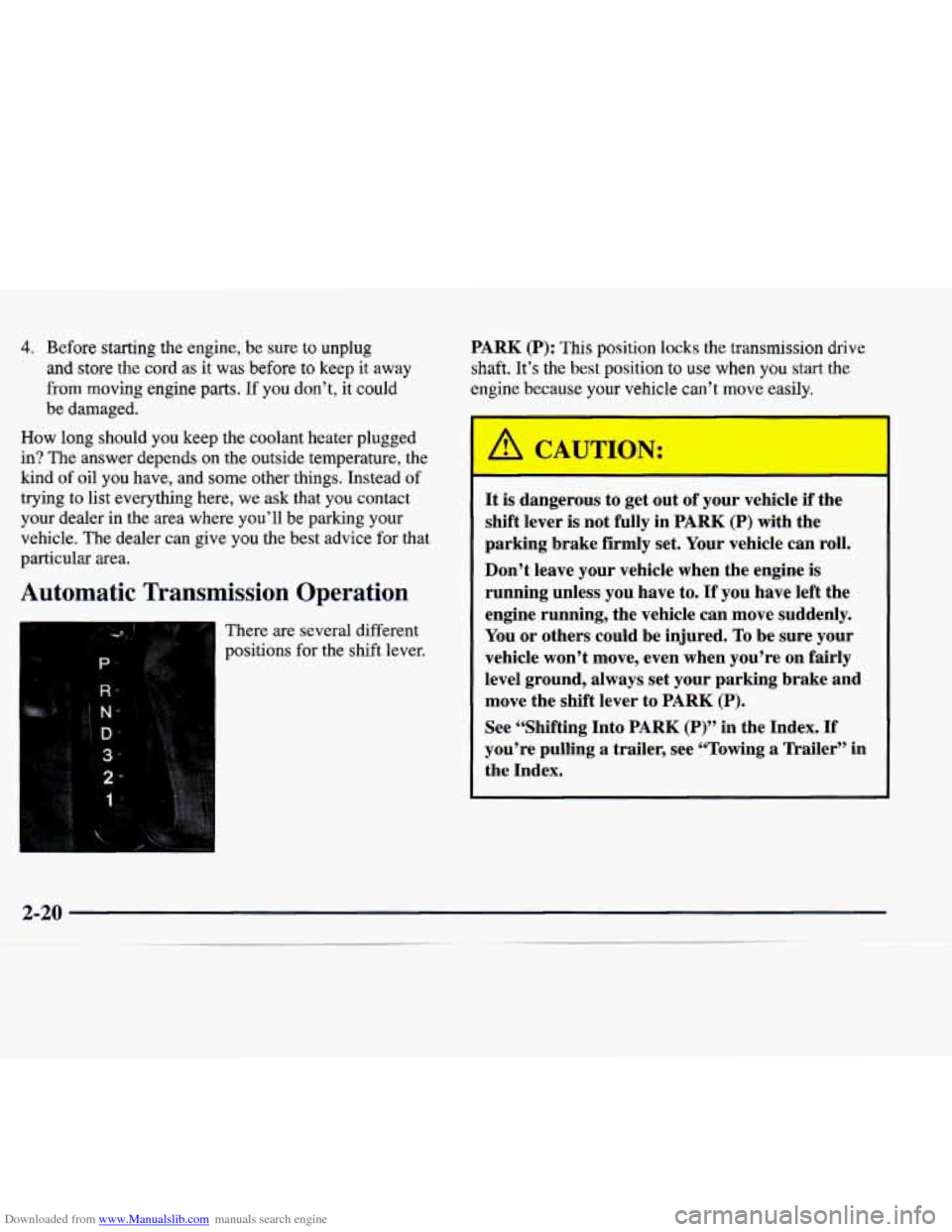
Downloaded from www.Manualslib.com manuals search engine 4. Before starting the engine, be sure to unplug
and store the cord as it was before to keep it away
from moving engine
parts. If you don’t, it could
be damaged.
How long should you keep the coolant heater plugged
in? The answer depends on the outside temperature, the
kind of oil you have, and some other things. Instead of
trying to list everything here, we ask that you contact
your dealer in the area where you’ll be parking your
vehicle. The dealer can give you the best advice for that
particular area.
Automatic Transmission Operation
There are several different
positions for the shift lever.
PARK (P): This position locks the transmission drive
shaft. It’s the best position
to use when you start the
engine because your vehicle can’t move easily.
It is dangerous to get out of your vehicle if the
shift lever
is not fully in PARK (P) with the
parking brake firmly set. Your vehicle can roll.
Don’t leave your vehicle when the engine is
running unless you have to.
If you have left the
engine running, the vehicle can move suddenly.
You
or others could be injured. To be sure your
vehicle won’t move, even when you’re on fairly
level ground, always set your parking brake and
move the shift lever to
PARK (P).
See “Shifting Into PARK (P)” in the Index. If
you’re pulling a trailer, see “Towing a Trailer” in
the Index.
Page 92 of 346
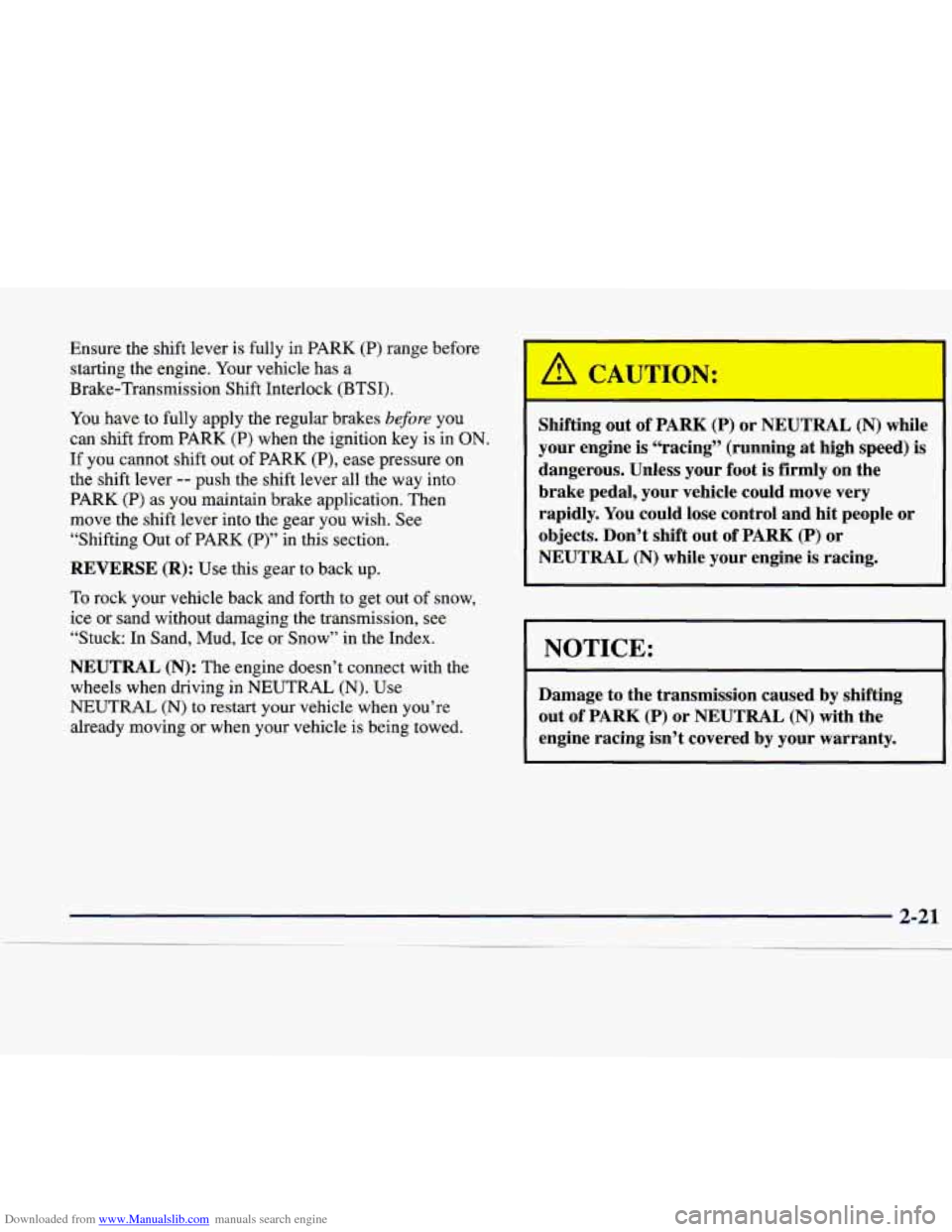
Downloaded from www.Manualslib.com manuals search engine Ensure the shift lever is fully in PARK (P) range before
starting the engine. Your
vehicle has a
Brake-Transmission Shift Interlock (BTSI).
You have to fully apply the regular brakes
before you
can shift from PARK
(P) when the ignition key is in ON.
If you cannot shift out of PARK (P), ease pressure on
the shift lever
-- push the shift lever all the way into
PARK
(P) as you maintain brake application. Then
move the shift lever into the gear you wish. See
“Shifting Out
of PARK (P)” in this section.
REVERSE (R): Use this gear to back up.
To rock your vehicle back and forth to get out of snow,
ice or sand without damaging the transmission, see
“Stuck: In Sand, Mud,
Ice or Snow” in the Index.
NEUTRAL (N): The engine doesn’t connect with the
wheels when driving in NEUTRAL
(N). Use
NEUTRAL
(N) to restart your vehicle when you’re
already moving or when your vehicle is being towed. Shifting
out of PARK (P) or NEUTRAL (N) while
your engine
is “racing” (running at high speed) is
dangerous. Unless your foot is firmly on the
brake pedal, your vehicle could move very
rapidly. You could lose control and hit people or
objects. Don’t shift out of
PARK (P) or
NEUTRAL (N) while your engine is racing.
NOTICE:
Damage to the transmission caused by shifting
out of
PARK (P) or NEUTRAL (N) with the
engine racing isn’t covered by your warranty.
Page 93 of 346
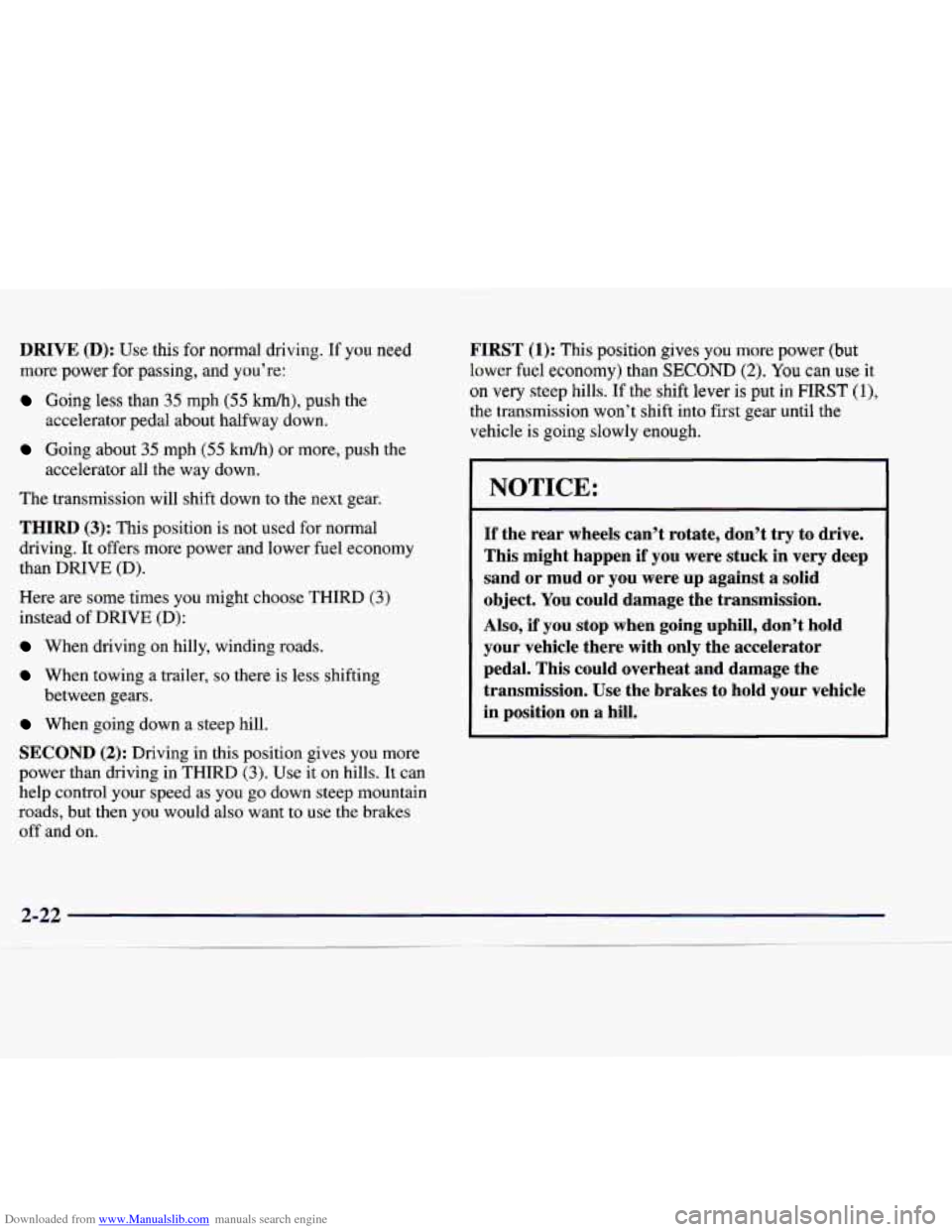
Downloaded from www.Manualslib.com manuals search engine DRIVE (D): Use this for normal driving. If you need
more power for passing, and you’re:
Going less than 35 mph (55 km/h), push the
Going about 35 mph (55 km/h) or more, push the
accelerator pedal
about halfway down.
accelerator all the way down.
The transmission will shift down to the next gear.
THIRD (3): This position is not used for normal
driving. It offers more power and lower fuel economy
than DRIVE (D).
Here are some times you might choose THIRD
(3)
instead of DRIVE (D):
When driving on hilly, winding roads.
When towing a trailer, so there is less shifting
between gears.
When going down a steep hill.
SECOND (2): Driving in this position gives you more
power than driving in THIRD
(3). Use it on hills. It can
help control your speed as you
go down steep mountain
roads, but then you would also want to use the brakes
off and on.
FIRST (1): This position gives you more power (Dut
lower fuel economy) than SECOND (2). You can use it
on very steep hills.
If the shift lever is put in FIRST (l),
the transmission won’t shift into first gear until the
vehicle is going slowly enough.
NOTICE:
If the rear wheels can’t rotate, don’t try to drive.
This might happen if you were stuck in very deep
sand or mud or you were up against
a solid
object. You could damage the transmission.
Also,
if you stop when going uphill, don’t hold
your vehicle there with
only the accelerator
pedal. This could overheat and damage the
transmission. Use the brakes to hold your vehicle
in position on
a hill.
Page 94 of 346
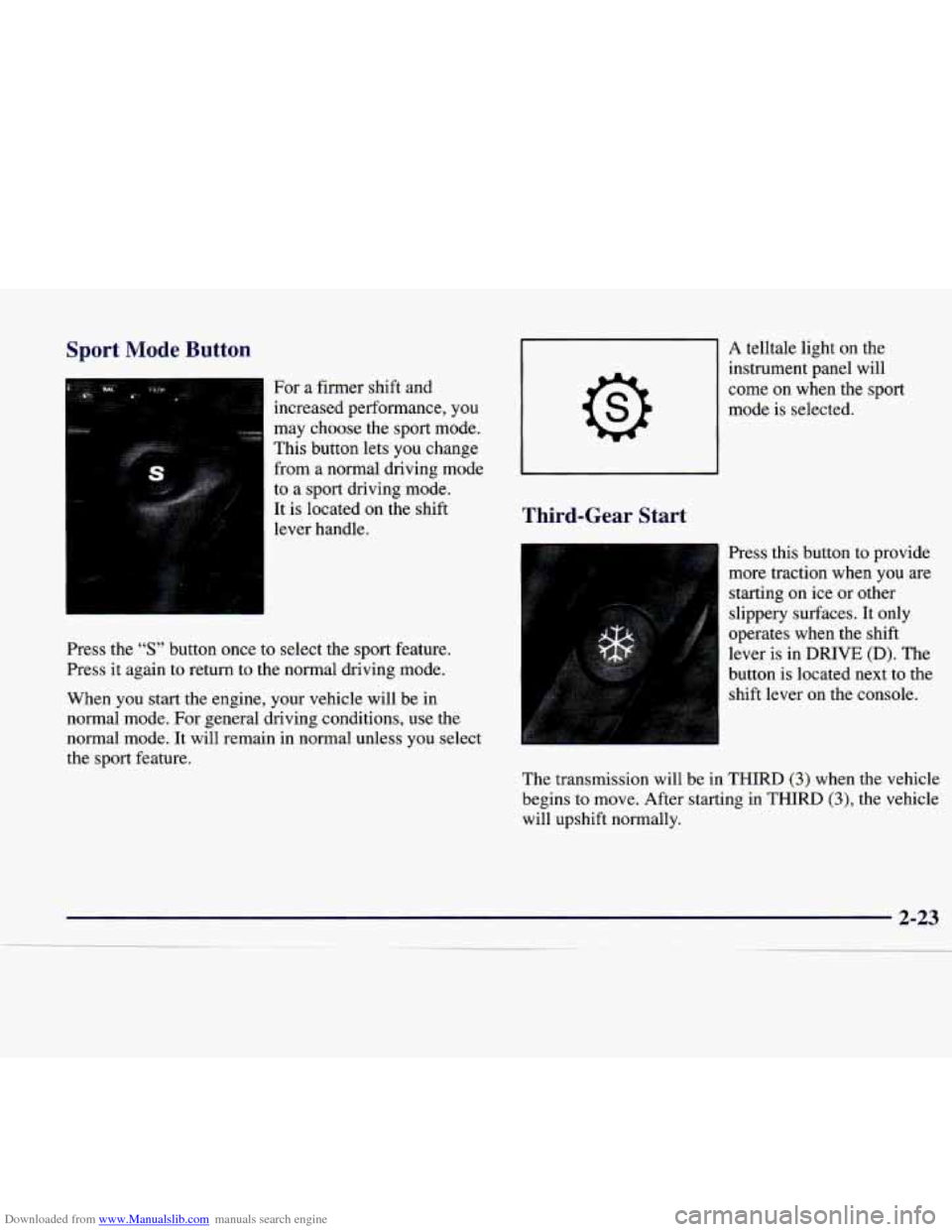
Downloaded from www.Manualslib.com manuals search engine Sport Mode Button
For a firmer shft and
increased performance, you
may choose the sport mode.
This button lets you change
from a normal driving mode
to
a sport driving mode.
It is located on the shift
lever handle.
A telltale light on the
instrument panel will
come on when
the sport
mode is selected.
I
Third-Gear Start
Press the “S” button once to select the sport feature.
Press it again to return to the normal driving mode.
When you start the engine, your vehicle will be in
normal mode. For general driving conditions, use the
normal mode. It will remain in normal unless you select
the sport feature. Press this button to
provide
more traction when you are
starting on ice or other
slippery surfaces. It only
operates when the shift
lever is in DRIVE (D). The
button is located next to the shift lever on the console.
The transmission will be in
THIRD (3) when the vehicle
begins to move. After starting in
THIRD (3), the vehicle
will upshift normally.
Page 95 of 346
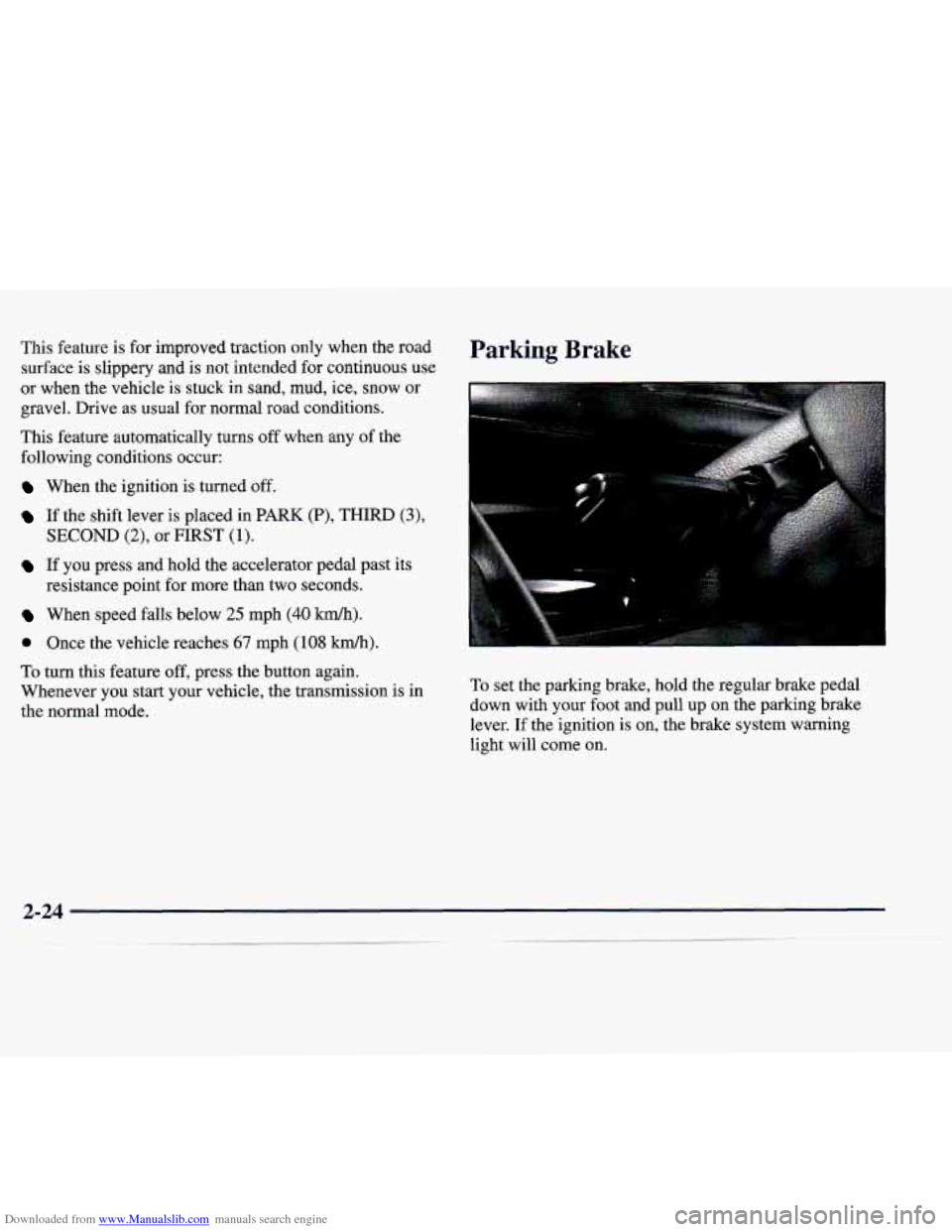
Downloaded from www.Manualslib.com manuals search engine This feature is for improved traction only when the road
surface is slippery and is not intended for continuous use
or when the vehicle
is stuck in sand, mud, ice, snow or
gravel. Drive as usual for normal road conditions.
This feature automatically turns off when any of the
following conditions occur:
When the ignition is turned off.
If the shift lever is placed in PARK (P), THIRD (3),
SECOND (2), or FIRST (1).
If you press and hold the accelerator pedal past its
resistance point for more than two seconds.
When speed falls below 25 mph (40 km/h).
0 Once the vehicle reaches 67 mph (108 km/h).
To turn this feature off, press the button again.
Whenever you start your vehicle, the transmission is in
the normal mode.
Parking Brake
To set the parking brake, hold the regular brake pedal
down with your foot and pull up on the parking brake
lever.
If the ignition is on, the brake system warning
light will come on.
Page 96 of 346
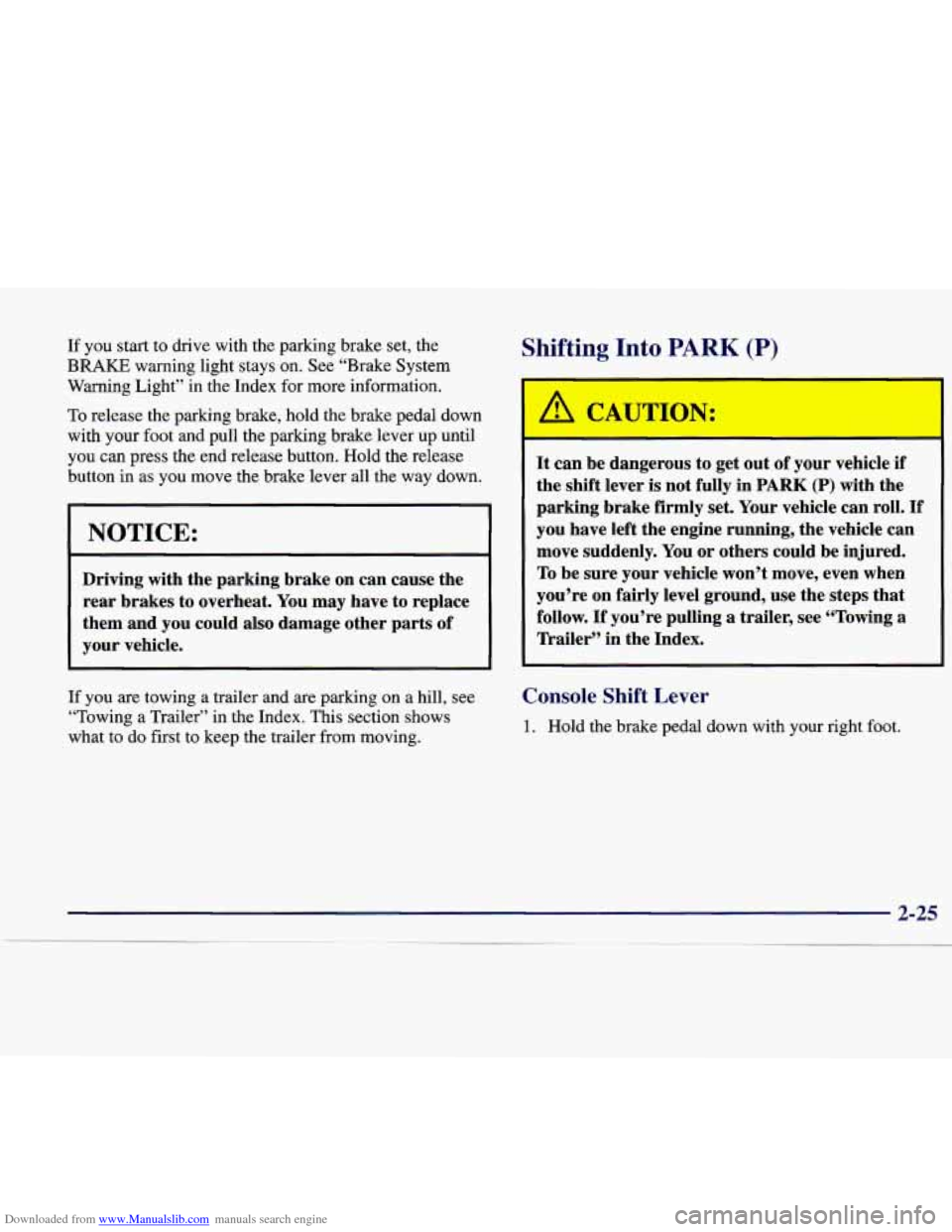
Downloaded from www.Manualslib.com manuals search engine If you start to drive with the parking brake set, the
BRAKE warning light stays on. See “Brake System
Warning Light” in the Index for more information.
To release the parking brake, hold the brake pedal down
with your
foot and pull the parking brake lever up until
you can press the end release button. Hold the release
button in
as you move the brake lever all the way down.
NOTICE:
Driving with the parking brake on can cause the
rear brakes to overheat. You may have to replace
them and you could also damage other parts of
your vehicle.
If you are towing a trailer and are parking on a hill, see
“Towing a Trailer” in the Index. This section shows
what
to do first to keep the trailer from moving.
Shifting Into PARK (P)
I
It can be dangerous to get out of your vehicle if
the shift lever is not fully in PARK (P) with the
parking brake firmly set. Your vehicle can roll. If
you have left the engine running, the vehicle can
move suddenly.
You or others could be injured.
To be sure your vehicle won’t move, even when
you’re on fairly level ground, use the steps that
follow.
If you’re pulling a trailer, see “Towing a
Trailer” in the Index.
Console Shift Lever
1. Hold the brake pedal down with your right foot.
Page 97 of 346
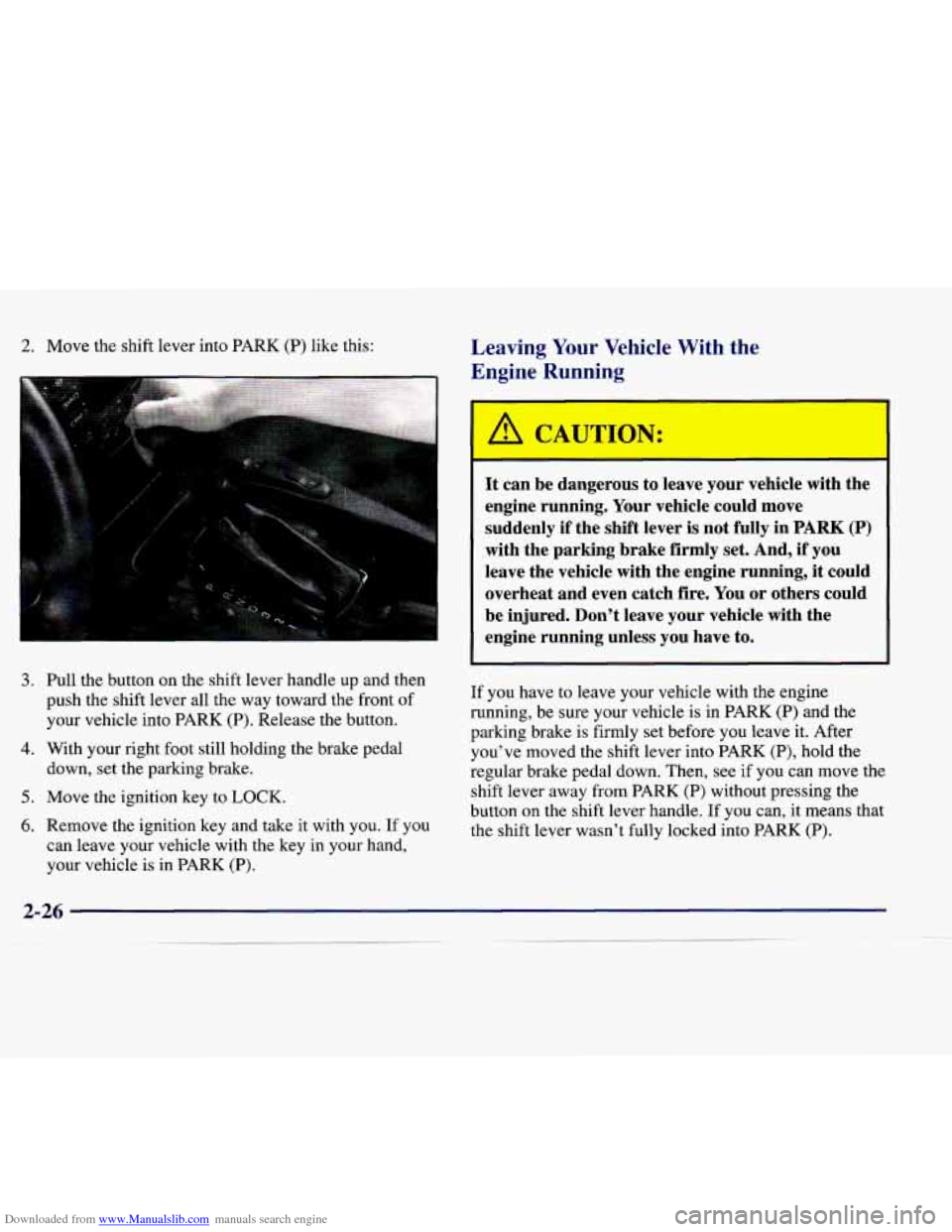
Downloaded from www.Manualslib.com manuals search engine 2. Move the shift lever into PARK (P) like this: Leaving Your Vehicle With the
Engine Running
3.
4.
5.
6.
Pull the button on the shift lever handle up and then
push the shift lever all the way toward the front
of
your vehicle into PARK (P). Release the button.
With your right foot still holding the brake pedal down, set the parking brake.
Move the ignition key to
LOCK.
Remove the ignition key and take it with you. If you
can leave your vehicle with the key
in your hand,
your vehicle is in PARK
(P).
L
It can be dangerous to leave your vehicle with the
engine running. Your vehicle could move
suddenly if the shift lever is not fully in
PARK (P)
with the parking brake firmly set. And, if you
leave the vehicle with the engine running, it could
overheat and even catch fire. You or others could
be injured. Don’t leave your vehicle with the
engine running unless you have to.
If you have to leave your vehicle with the engine
running, be sure your vehicle
is in PARK (P) and the
parking brake is firmly set before you leave it. After
you’ve moved the shift lever into PARK
(P), hold the
regular brake pedal down. Then,
see if you can move the
shift lever away from PARK (P) without pressing the
button on the shift lever handle. If you can, it means that
the shift lever wasn’t fully locked
into PARK (P).
Page 98 of 346
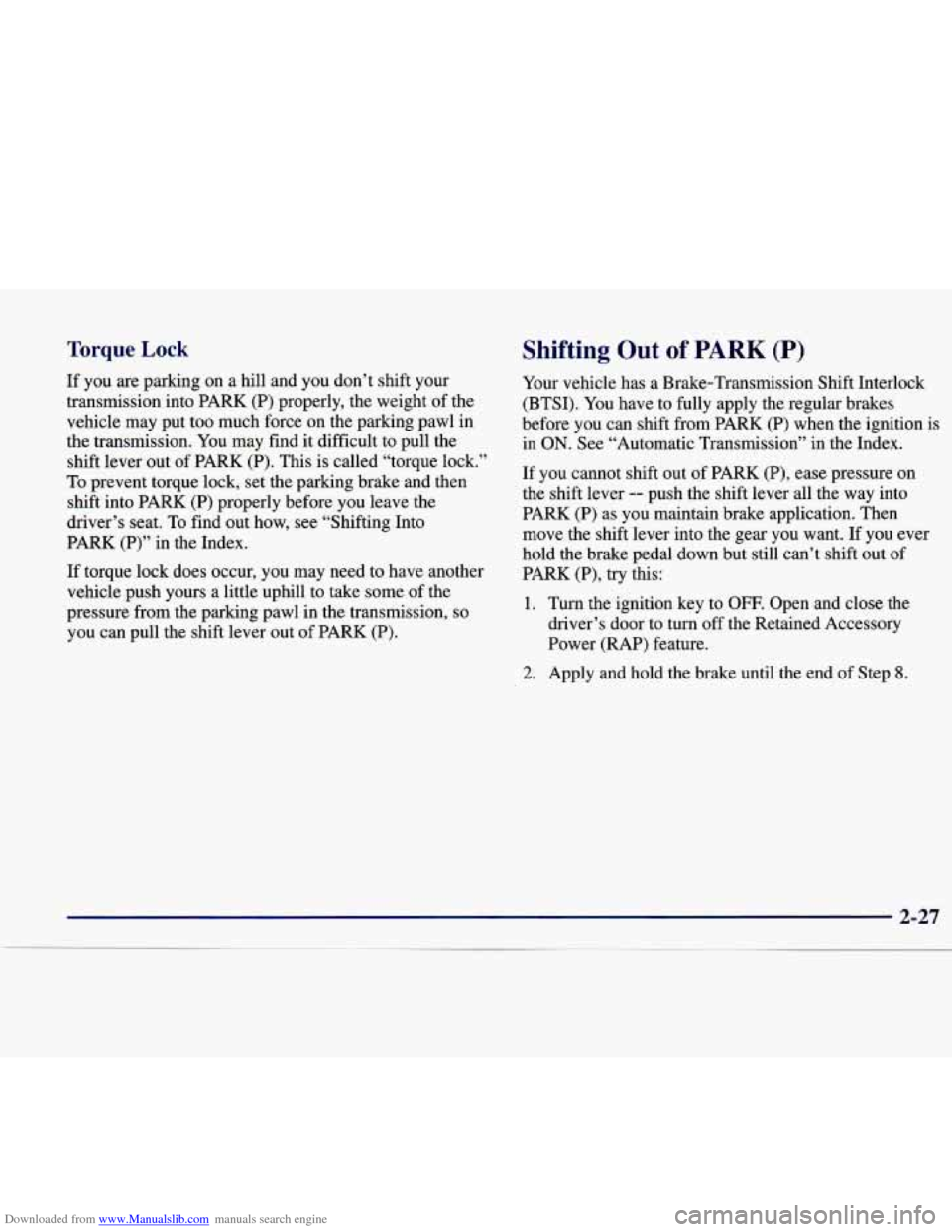
Downloaded from www.Manualslib.com manuals search engine Torque Lock
If you are parking on a hill and you don’t shift your
transmission into PARK (P) properly, the weight of the
vehicle may put too much force on the parking pawl
in
the transmission. You may find it difficult to pull the
shift lever out of PARK (P). This is called “torque lock.”
To prevent torque lock, set the parking brake and then
shift into PARK
(P) properly before you leave the
driver’s seat.
To find out how, see “Shifting Into
PARK (P)” in the Index.
If torque lock does occur, you may need to have another
vehicle push yours a little uphill to take some of the
pressure from the parking pawl in the transmission,
so
you can pull the shift lever out of PARK (P).
Shifting Out of PARK (P)
Your vehicle has a Brake-Transmission Shift Interlock
(BTSI). You have to fully apply the regular brakes
before you can shift from PARK (P) when the ignition is
in
ON. See “Automatic Transmission” in the Index.
If you cannot shift out
of PARK (P), ease pressure on
the shift lever
-- push the shift lever all the way into
PARK (P) as you maintain brake application. Then
move the shift lever into the gear you want. If you ever
hold the brake pedal down but still can’t shift out of
PARK
(P), try this:
1. Turn the ignition key to OFF. Open and close the
driver’s door to turn off the Retained Accessory
Power (RAP) feature.
2. Apply and hold the brake until the end of Step 8.
Page 99 of 346
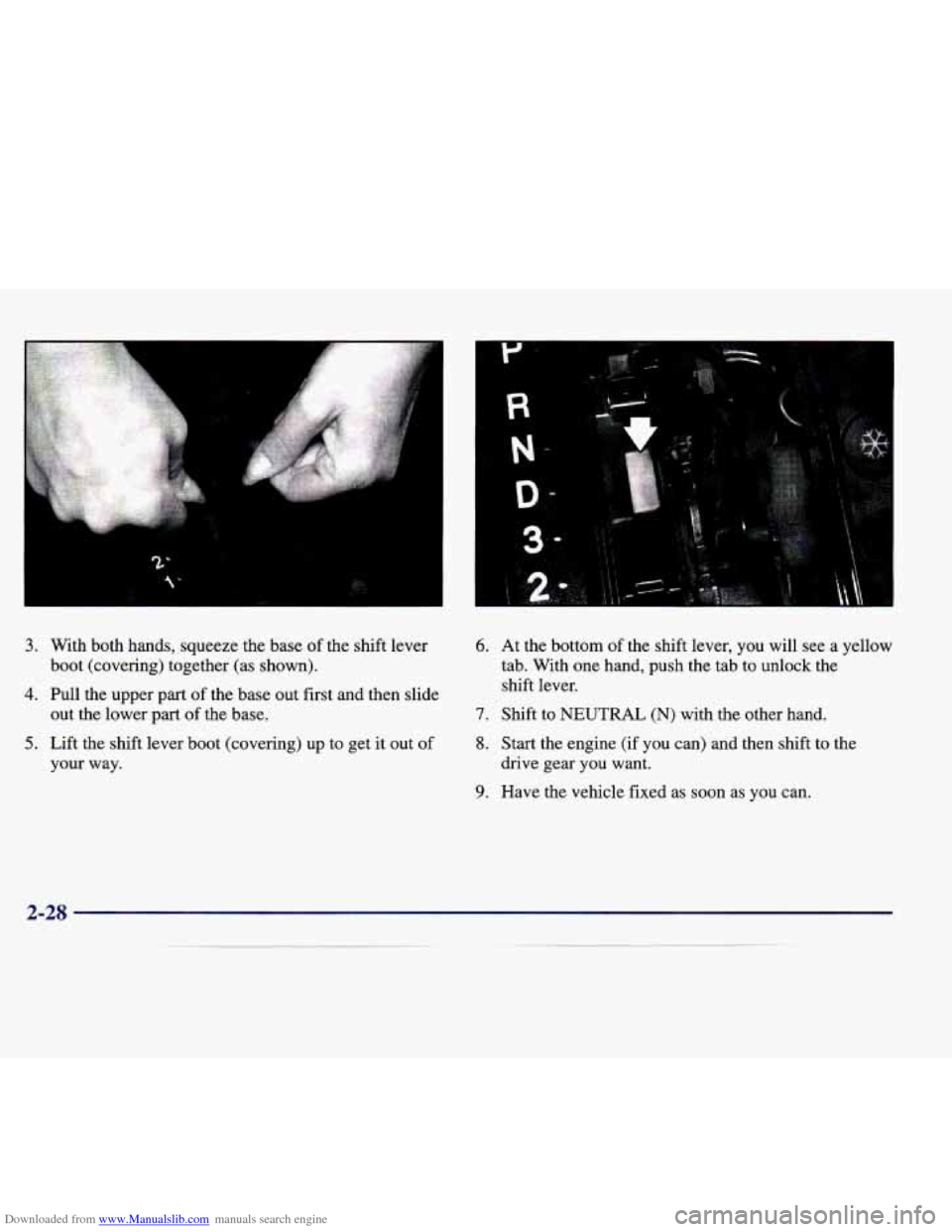
Downloaded from www.Manualslib.com manuals search engine A
3. With both hands, squeeze the base of the shift lever
4. Pull the upper part of the base out first and then slide
5. Lift the shift lever boot (covering) up to get it out of
boot (covering) together (as shown).
out the lower part
of the base.
your way.
6. At the bottom of the shift lever, you will see a yellow
tab. With one hand, push the tab to unlock the
shift lever.
7. Shift to NEUTRAL (N) with the other hand.
8. Start the engine (if you can) and then shift to the
drive gear you want.
9. Have the vehicle fixed as soon as you can.
Page 100 of 346
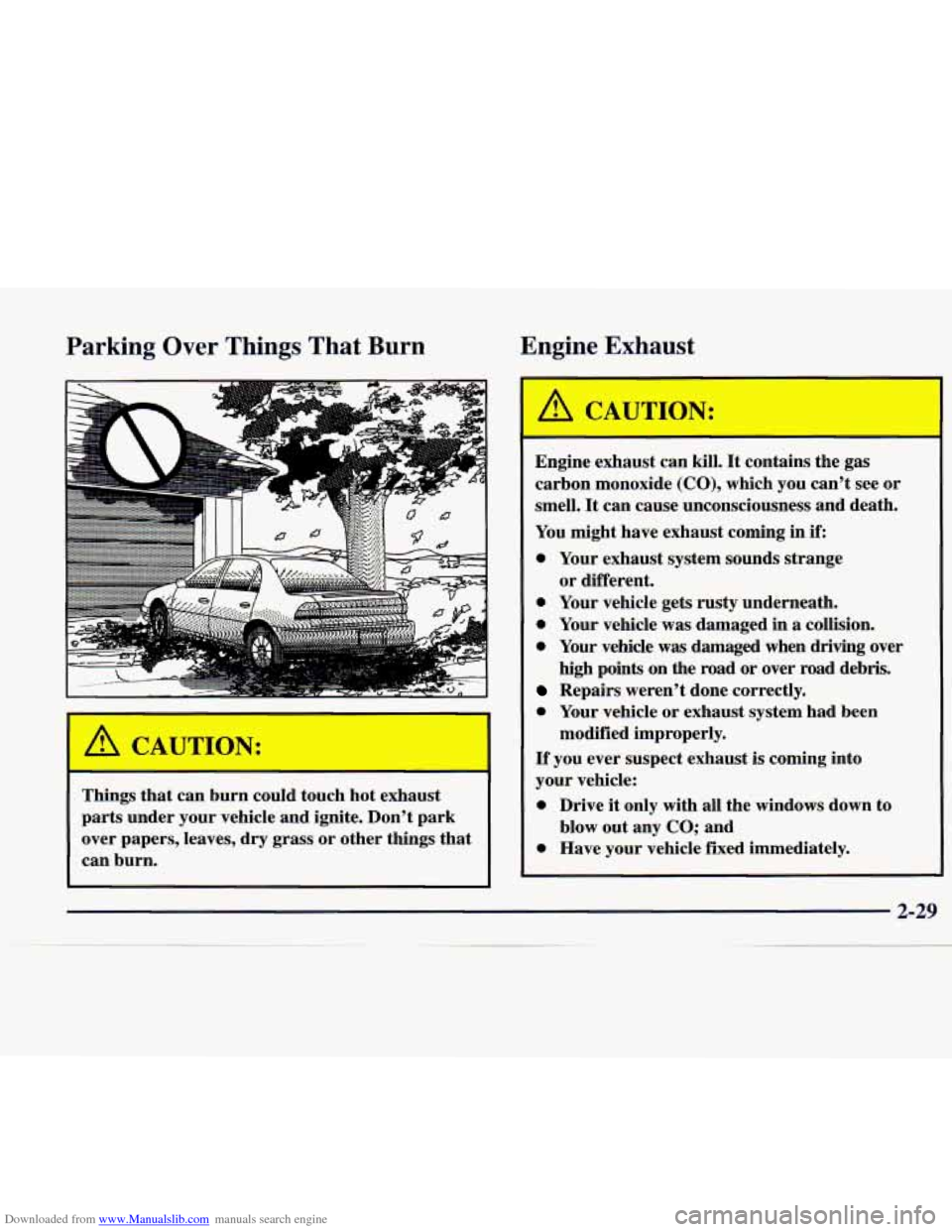
Downloaded from www.Manualslib.com manuals search engine Parking Over Things That Burn Engine
Exhaust
I A CAUTION: I
Things that can burn could touch hot exhaust
parts under your vehicle and ignite, Don’t park
over papers, leaves, dry grass or other things that
can burn. Engine exhaust can
kill. It contains the
gas
carbon monoxide (CO), which you can’t see or
smell.
It can cause unconsciousness and death,
You might have exhaust coming in if:
0 Your exhaust system sounds strange
0 Your vehicle gets rusty underneath.
0 Your vehicle was damaged in a collision.
0 Your vehicle was damaged when driving over
high points on the road or over road debris.
Repairs weren’t done correctly.
0 Your vehicle or exhaust system had been
If you ever suspect exhaust is coming into
your vehicle:
0 Drive it only with all the windows down to
0 Have your vehicle fixed immediately.
or
different.
modified improperly. blow out any
CO; and